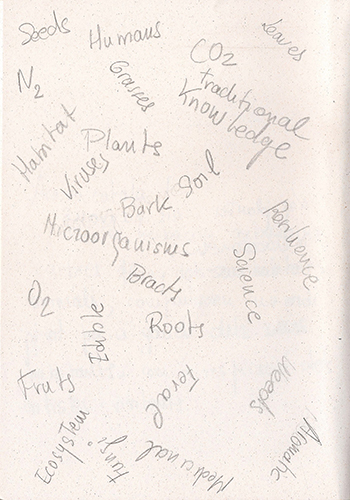
[Ga] ⌂
Tales from a Suburban Garden
Table of contents:
A Misloved Garden?
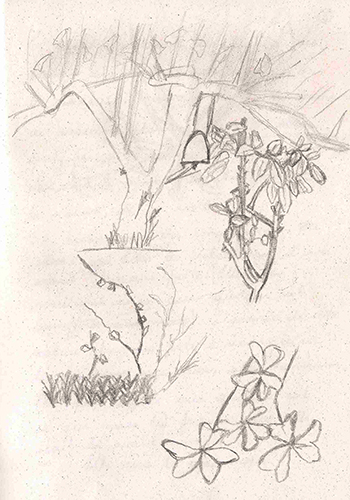
[Pr]
[Len] I see a garden that we have tried to domesticate, to maintain, but without gardening skills. I see an intention to act but without a method.
I see a resilient garden, plants that adapt to the stresses they encounter (awkward pruning), excessive density.
I see plants that have escaped from humans, that have invited themselves.
Plants in poor health that I would like to take elsewhere, « transplant ».
Plants in the wrong place.
[Pr] The garden, it is the plants. The plants that have been chosen. The species that bear witness to what humans are. A traveler … A domesticator … A dominator.
Who chose them? Who planted them? So many questions that lead us back to the gestures of those who made it.
Is the fig tree a souvenir of a trip or a holiday in the south?
Is the chestnut tree there by chance or because someone found it beautiful?
This garden is difficult to understand.
This garden is difficult to decipher…
It is a patchwork … certainly unfortunate …
It may once have been a spice garden… It may once have been coherent … May be it was even beautiful …
It is true that I do not see this beauty. It has scars. It has bruises. It is broken. It is a memory as well, like the old man who proudly displays what he once was. He is the 80-year-old boxer who shows us his scars. He is the former ballerina who pathetically does a few steps. He is the old barfly who tirelessly recounts the supposed adventures of his life. Real or fantasized, these lives, these memories, these remains are stories or lies that we can believe or not…
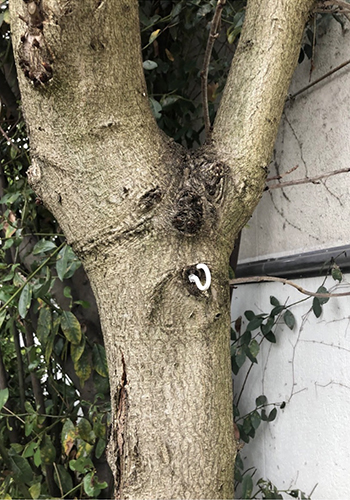
[Ge] Actually, in this garden, everything should be changed, starting with the removal of the small laundry hook planted in this poor chestnut tree already eaten by the chestnut canker!
[Va] The garden of the Malina house is, first of all, small. This is not a problem, in small jars there is good jam.
Secondly, it is not preserved in a neat and aseptic way. This, for me, is not a problem either; not all gardens have to be Versailles or an English park. Cultivated plants look good, and some wild ones make their way there (a sign of resilience, no doubt).
Third, it is a varied, diverse, biodiverse garden. Although small, I have counted, at least, 25 species of cultivated plants and 25 more of wild plants that make way next to the others and in a central parterre, in which some works of repair of the house caused difficulties in the plants that were grown there.
We are now discussing, with Annick, the event’s coordinator, the difference between this garden and what we mapped, with the same focus, on July 15 and 16, 2021 in Barcelona.
The one in Barcelona was a large 19th century historic garden (at least 10, if not 20 or more times larger than the Malina house), with more than 250 species of cultivated and wild plants, more worked in gardening. For me, that garden – on which I have worked historical, literary and botanical aspects, and which is that of my institution – is magnificent, superb, difficult to overcome, but this – modest, if you will, less spectacular – is not, not at all lacking in interest and attractive elements.
Hedges & Relations
[Ge] There is […], the neighbour’s Virginia creeper that once grew over the corner of the wall and was cut back. There are some kind of irises, I don’t know, under the office windows, which have been pruned back for some strange reason … as if they are not allowed to grow more than 20 centimetres.
And then there are those plants assigned the thankless task of making hedges: crotons and holly in rectangles so as not to obstruct the passage of humans. Poor prickly holly made harmless.

[Bo] The sound of a human hand on a tree trunk
[Ga] Herbaceous plants, shrubs and trees far from their natural habitats, share a private garden for the enjoyment of its inhabitants and as an inspiration for artists and visitors. Plants and humans interact.
[Va] We can never forget the relationship between people -human societies- and plants -natural landscape, agricultural landscape …-, which have led to a management (or several managements, one traditional, more sustainable, and another industrial, often more or less destructive, of habitats and of knowledge) of the biodiversity, of the territory, of the planet. Humans are the only biological species that can handle – all right or wrong – all the others, and this situation – although now heavily challenged by the viral plague that affects us – is likely to last. Personally, and without any scientific experimentation, I have the idea that this condition of managing species of all the others is given to the human being by two circumstances, by two facts. On the one hand, the fact of speaking: the language, the languages. This type of communication makes us different and unique. On the other hand, the fact that we treat our food in a special way: the fact of cooking, and, even more, the gastronomy. The preparation – from simple to very complex – of food and especially the theorization of this process and its consumption also make us different, unique. This second distinctive quality of our species – or, better, subspecies, Homo sapiens sapiens – has a lot to do with plants, with nature, with traditional knowledge about biodiversity (ethnobiodiversity). It is not surprising, then, that in the garden that is now our centre of attention- or in any garden or in any structure of urban greenery – we recognize useful plants far beyond the decoration and the well-being that causes us to see vegetables – Ulrich effect – inside of which food in the broadest sense plays a relevant role.
[Mi]
Hiding places
under a leaf
behind a bush
in the soil
pretending to be someone else
or even
cross the border
from nonliving
to living
[Ga] Extracts from the poem by Narcís Comadira
Moviment d’amor
el creixement de les plantes, la lenta
confiança de la llavor, l’obscur
destí de l’arrel, la fugaç
meravella de la flor, el fúlgid
esclat del fruit.
[Ci] Could you leave a garden untamed?
[Mi] The Beauty of not understanding fully
Death
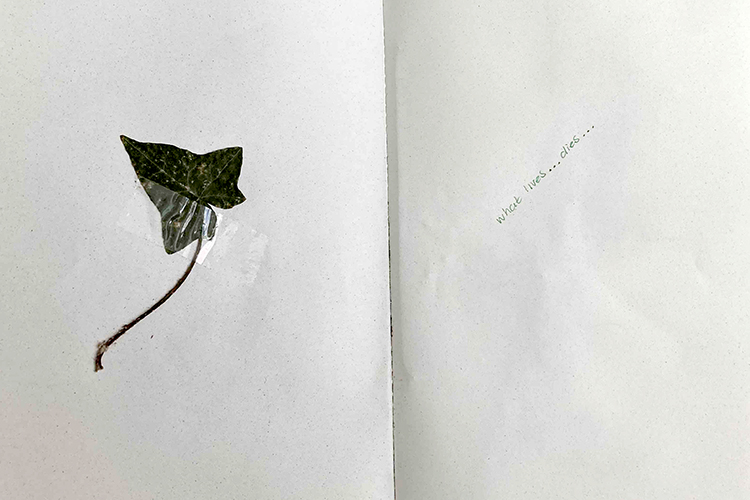
[Ci] What lives, dies
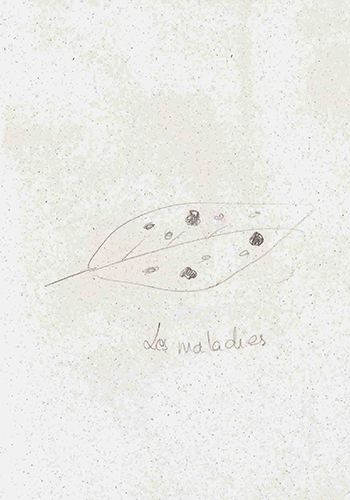
[Ga] Diseases
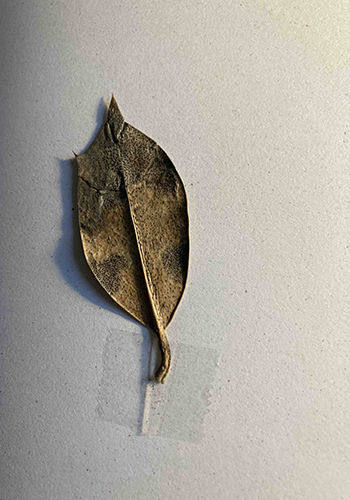
[Mi] These leaves won't stay the same how long would it take for this leaf to disappear?
Resilience
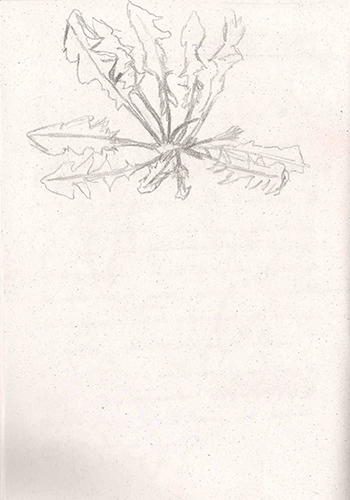
[Ga]
[Ga] For me, this garden is a very good example of resilience. Even if the garden is not very well maintained the plants are growing, they have leaves, fruits and seeds, they are trying to resist, to survive.
Some plants are inhabited by pathogens that can complete their life cycles on the leaves, fruits or bark. A complete ecosystem!
Hedera (ivy), Ilex aquifolium (holly), Taxus baccata (yew), Rosmarinus officinalis (rosemary), some ornamentals, invasive plants, even some medicinal plants, a « hotspot » of biodiversity in a small urban corner.
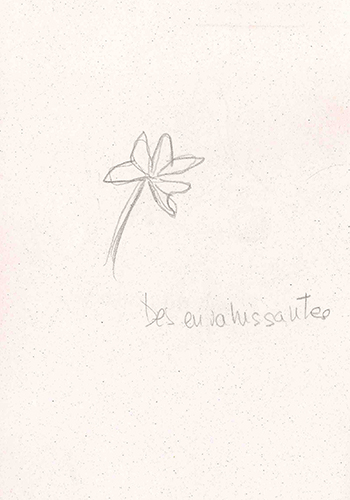
[Ga]
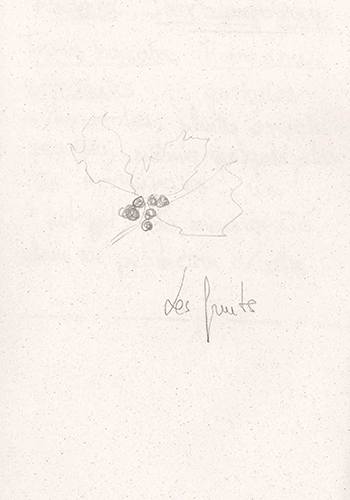
[Ga]
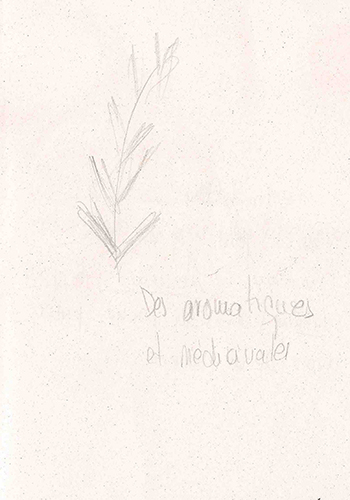
[Ga]
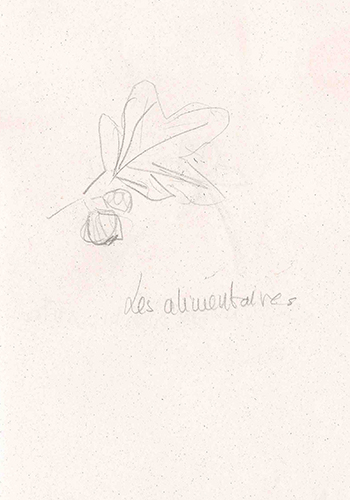
[Ga]
[Pr] The garden, it is the plants. The plants that came without being chosen. Weeds, spontaneous or wild plants, whatever name we give them, they are the symbol of nature’s strength, of its resilience.
Herbs are conquerors. They are the scouts of an ever-ready army. The army of nature that is always ready to reclaim the land we abandon. It reminds us that whatever we do to it, it was here before us…
It will be there after us.
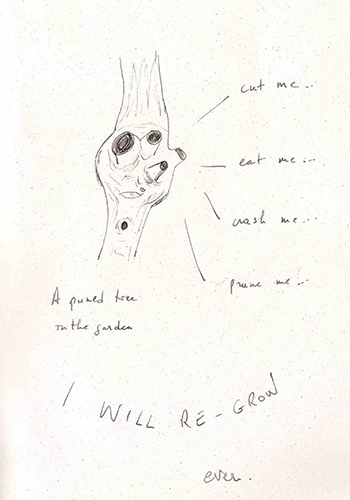
[Se] cut me... eat me... crash me... prune me... A pruned tree in the garden I WILL RE-GROW ever
Life Travels Light
[Ca] Seeds is the most resilient version of plants, a dormant version of life.
Optimized for outer space: robust, light weight, long shelf life, no difficult storage conditions.
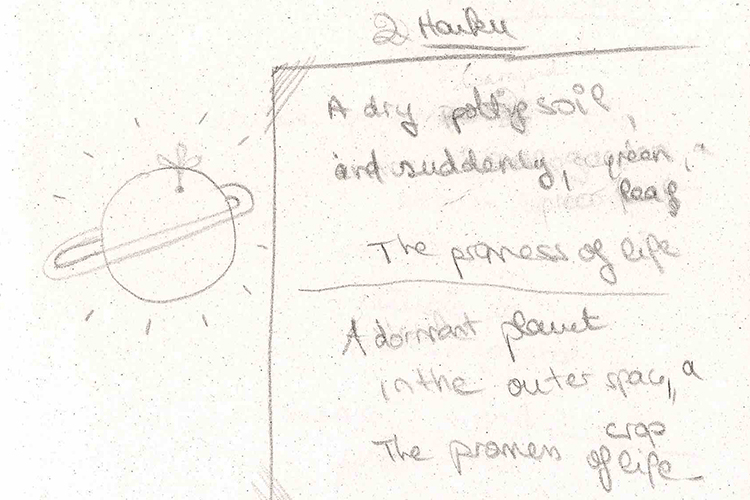
[Ca]
[Ca] The promess of life
A dry potting soil
and suddenly green leaf
The promess of life
A dormant planet
in the outer space, a crop
The promess of life
Contribution material from
[Bo] Karine Bonneval
[Bu] Annick Bureaud
[Ca] Lucie Campagnolo
[Ch] Quentin Chevrier
[Ci] Laura Cinti
[Qu] Kim Doan Quoc
[Fi] Eva Figueras Ferrer
[Ga] Teresa Garnatje Roca
[Ge] Lauranne Germond
[Ko] Tatiana Kourochkina
[Len] Loïc Le Noan
[Ma] Kristina Maurer
[Mi] Marit Mihklepp
[Na] Sophie Nadot
[Pr] Cyrille Prestianni
[Re] Mar Redondo Arolas
[Ro] Meredith Root-Bernstein
[Bu] Marc-André Selosse
[Ser] Perrine Serre
[So] Jean-Luc Soret
[To] Anaïs Tondeur
[Va] Joan Vallès Xirau
Roots & Seeds XXI. Biodiversity Crisis and Plant Resistance is an international cooperation project between Ars Electronica (AT), Leonardo/Olats (FR), University of Barcelona (ES) and Quo Artis (ES) as lead partner. It is co-funded by the Creative Europe Programme of the European Union. Leonardo/Olats has the support of the Daniel and Nina Carasso Foundation.
Quo Artis (SP lead partner), Ars Electronica (AT), Leonardo/Olats (FR), University of Barcelona (ES).
Project developed with the support of the Creative Europe Programme of the European Union.


Leonardo/Olats
Observatoire Leonardo des Arts et des Techno-Sciences
À propos / About | Lettre d'information Olats News



Pour toute (re)publication, merci de contacter / For any (re)publication, please contact Annick Bureaud: info@olats.org
Pour toute question concernant le site, merci de contacter / For any issue about the website, please contact: webmaster@olats.org
Design Thierry Fournier
© Association Leonardo 1997-2022


